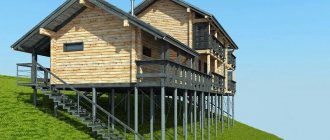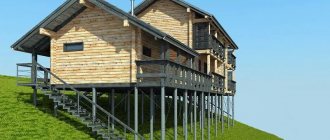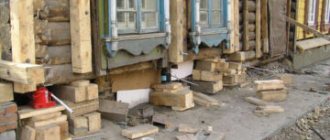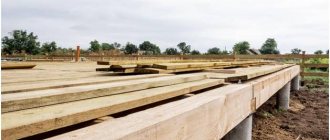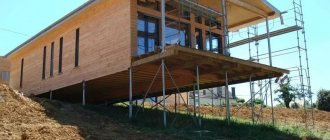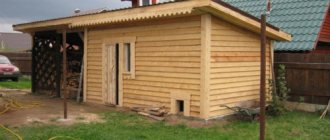When building a house, great importance is given to the construction of the foundation. We have said more than once that the foundation is the foundation of the future home. That's why it needs to be taken seriously. The soil and soil quality of the area where the house will be built is of key importance when choosing the type of foundation. Today we will look at the pros and cons of a pile foundation. The entire construction technology depends on the type of soil on the site, so before starting to build a house, we recommend that you definitely do geotechnical surveys. This will allow you to accurately determine the type of foundation for building your home.
In many regions of Russia, swampy, flooded or weak-bearing soils predominate. This makes the construction process problematic. This is especially true for the construction of private houses. But nevertheless, it is necessary to build somehow, and the use of a traditional strip or even slab foundation on such soils is simply unacceptable. In such cases, a pile foundation comes to the rescue. It is based on the installation of supporting structures. Such structures ensure good contact of the future house with dense layers of soil. And most importantly, they allow you to build very large and massive structures without fear for their stability. But is such a foundation good and safe? Are there any disadvantages of a pile foundation and what are they? Let's sort it out in order.
An example of a pile foundation for a house
Next, we will examine in detail the lighter version of the pile foundation. This includes screw piles. We'll tell you how to install screw piles so that they don't fail. And also what are the advantages of screw piles for the foundation of a house.
Foundation on screw piles
What are screw piles? What are their features and convenience? And how to make a foundation with their help? Screw piles are such a support structure. It is a system of pipes that are immersed in the ground to a certain depth. Spiral blades are welded at the bottom of these pipes (as in the photo). This design allows you to screw piles into the ground. And the blades play the role of cutting, with approximately the same effect as on screws. The sharp tip of the pile makes it easier for it to penetrate the ground. And the thread, in addition to being used for screwing, is also a support unit on which the pile actually rests.
How is the support supported and how reliable is it, you ask? We answer: such a pile is supported by the friction force that occurs between the soil and the side surfaces of the pile (pipe). This design is reinforced by the same blades that we have already talked about. They bear part of the load, which makes such a support very reliable, with proper installation, of course. By the way, the installation of such piles itself has a lot of subtleties that must be observed. Failure to comply with them may result in the pile being flimsy and unreliable. So, in order to evenly distribute the load on each pile, the installation is carried out according to a pre-calculated scheme. A so-called pile field is formed. It ensures an even load on each support.
Grillage
When the piles are already immersed, their upper parts are cut off in such a way that a flat plane is obtained. Then they make a grillage or otherwise call it a load-bearing belt. This is the main structure that distributes the load from the walls. And most importantly, thanks to it, the load on the pile system is distributed evenly, without overloading any of the piles, which gives this structure reliability and durability.
The structure and functions of the grillage are very similar to the design of a strip foundation. The difference in this design is that the grillage, instead of being supported on the ground, like a strip foundation, is supported on piles. In order for the structure to become rigid and less susceptible to lateral loads, the hollow tubes of the piles are filled with concrete after installation. This creates additional stability and rigidity of the structure.
Of course, there are both pros and cons of a pile foundation. But the clear advantage of screw piles is that when installing them, it is not necessary to immerse them until they come into contact with dense layers of soil, as with other piles. The peculiarity of their design allows them to reliably hold the building with sufficient penetration into the ground. Screw piles are a hanging type of piles.
Grillage arrangement
Installation of a pile field
The entire process of installing screw piles can be reduced to several stages.
Step 1. Preparatory steps
This includes coating the pile pipes with a wear-resistant primer suitable for metal work. You need to apply two layers, the second - strictly after the first has dried. Drying time - according to the instructions for the primer used.
The stage is not obvious, but ignoring it will lead to a gradual decrease in the bearing capacity of the foundation. It can fall below normal in 15–20 years – in conditions of chemically neutral soils and in 10–12 years – in acidified or, on the contrary, alkaline soil.
Step 2. Installation of the first pile
You should start with one of the corner supports. The terrain will tell you which one - you need to choose the corner where the soil rises higher than the rest.
The pile is screwed to the required depth and cut as accurately as possible - after all, it will become a reference for the rest.
Step 3. Installation of the remaining supports
It should be done in the following sequence:
- A screw pile located diagonally to the reference.
- The remaining corners, starting from higher to lower points of the ground.
- The supports located along the perimeter are also from highest to lowest.
- Central bundle of screw piles.
- Internal supports - if provided for in the plan.
Using a water hose level will help you accurately cut the piles first. In terms of accuracy, it far exceeds the level of the stiffest cord. The latter, already at a 4-meter length, will sag by at least 3 mm.
It would seem that a laser level is capable of providing greater accuracy. But in reality, not everything is so rosy. Firstly, the intermediate supports will become an obstacle to the beam. And secondly, during installation, the technician may drop the tripod with the level, and the device will have to be adjusted again. By doing this in the absence of additional control points on special supports or a second level already configured, you can obtain rather low accuracy, less than that of a hydraulic level.
Pros and cons of pile foundations and screw piles
Below we will try to highlight the obvious advantages of screw piles. Of course, any choice in favor of one or another method of installing a foundation depends more on the conditions that exist specifically on your site. But we decided to highlight the general advantages that will help you make a choice based on your individual conditions. And so, the advantages of screw piles include:
- Fast installation.
- Screw piles can be installed manually. This fact makes it possible to build such a foundation next to ready-made buildings.
- Price. Screw piles cost much less than other types of foundations.
- Screw piles can be reused. If the need arises, such piles can be removed and reused elsewhere.
- The big advantage is that installation of screw piles does not require excavation work.
- Screw piles allow construction in areas where there are slopes or folds in the terrain.
- Another important advantage is that during installation you do not need to use complex equipment, which makes the installation process easier and cheaper.
The advantages of screw piles
The disadvantages of a pile foundation and screw piles in particular are given below. The disadvantages are associated not with the structure itself, but with the conditions in which it is unacceptable to use this type of foundation. Here's what it includes:
- Corrosion may appear on the piles, as operating conditions contribute to this.
- In regions where there is high seismic activity, the use of screw piles is prohibited.
- Do not immerse in rocky soil.
- If you plan to install screw piles on loose and weak-bearing soils that do not provide acceptable lateral support for the piles, then additional study is required to determine the sufficient immersion depth of the screw piles.
Often, as it happens, many of the shortcomings of screw piles are deliberately hushed up by manufacturers. In this regard, when choosing a pile type of foundation, you need to understand the design features yourself or have a trusted person who understands this. And most importantly, have an idea of the properties of such piles. To choose the most suitable and high-quality option for screw piles.
Screw pile design
What supports should I use?
Among the existing types of pile foundations, such load-bearing structures are chosen, the installation of which does not generate additional vibrations and force loads that can lead to the destruction of the house and weakening of the soil. Based on this principle, houses are not raised on driven piles .
In private housing construction, the technology of raising a house on bored or screw supports is used. The implementation of the first method requires significant labor and time costs. At the same time, the strength and wear resistance of bored columns will directly depend on the quality of the concrete, the reliability of the reinforcement cage and compliance with SNiP requirements during the installation process.
Most professional developers offer services for lifting houses and cottages onto their own screws, which is much cheaper, easier to implement, and the work itself takes 2-4 days. Pile foundations stand out due to their practicality during construction on various types of soil.
What are the types of screw piles?
Screw piles come in various types. They are used depending on soil conditions and other parameters that we will consider. So what are the types of screw supports that are used in the world of modern construction? For convenience, we will divide all types of screw piles into categories.
By area of application in construction
For those who know little about the construction craft, it seems that this type of foundation is used very rarely. But that's not true. This type is used much more widely.
Below we list the areas in which pile structures, screw piles in particular, are widely used:
- Capital construction.
- Individual construction for housing.
- Construction of greenhouses.
- Construction of hangars.
- Fences or enclosures, etc.
- Bridges, piers and other hydraulic structures.
- Load-bearing supports of power lines, masts, etc.
Over the past few decades, the popularity of this type of base has increased significantly. This means that the scope of application of screw piles is only growing and this process is not over yet.
Screw piles design
What are the sizes of piles?
In the manufacture of screw piles, steel pipes of different diameters . Depending on the application, different pile sizes are used. The larger the scale of construction, the thicker the piles should be, this is understandable. But the most common are pipes with a diameter of 108 mm. This size optimally combines fairly good penetration into the ground and high load-bearing capacity.
The diameter range of pile pipes ranges from 57-219 mm. Of course, in some cases, pipes with a larger diameter can be used.
Since the topic of this article is devoted specifically to private housing construction, we will make an amendment that pipes over 159 mm are usually not used. Since with such a thickness there are already certain difficulties in driving piles.
The length of the piles is also key and has several options. Standard sizes range from 1650 mm to 9000 mm. The length of the piles is selected depending on the conditions in which the building must be erected. It is important to understand that the more complex the soil area, the longer the length should be chosen when using piles.
How many blades should there be?
Piles come in various designs. Designs come with one blade or with several blades. Single-blade piles are usually used only on relatively stable soils. Piles with several blades are more suitable for complex and low-bearing soils.
It is important to know. In order not to lose traction with the ground when installing piles, you cannot reverse (reverse movement when screwing in). And also the load on the pile should not be exceeded.
Of course, when constructing important buildings, especially if the soil is weak-bearing, then it is necessary to use multi-bladed piles. Since their design provides greater stability and can withstand higher loads. This is a definite plus in favor of choosing multi-bladed screw piles.
Types of piles
For critical buildings on weak-bearing soils, multi-bladed piles are used, which demonstrate greater resistance to possible loads. Also, an additional argument in favor of choosing just such piles can be the fact that with an increase in the number of blades on the pile, it becomes possible to reduce the diameter of the trunk. And this makes it much easier to dive into the ground.
But it is imperative to ensure that the wall thickness provides the required structural rigidity.
Types of screw pile tips
The main function of the tips is to take on the load when the pile is driven. Therefore, this creates high demands on this structural element. Let's take a closer look at what types of tips there are for screw piles and in which cases which tip is best to use.
Types of screw piles
There are the following types of screw pile tips:
- The first type of tips is welded screw pile tips . They are made by narrowing the thickness of the pipe. Wedge-shaped sections of the pipe are cut out, and then the remaining parts are connected in such a way that a cone is obtained. Next, the seams are welded into a single structure. In this way, a pointed end is achieved. But it is worth noting that this type is only suitable for relatively weak soils. Otherwise, possible obstacles and inclusions of hard areas will simply destroy such a tip.
- The second type of tips, which is distinguished by its reliability and durability, is the cast tips of screw piles. They are made by casting from durable steel, and then additionally attached to the pipe. Such tips are massive, have greater thickness and have the ability to destroy inclusions that occur when installed in the ground. These tips are perfect for difficult soils that have a high density.
Screw pile options
What material are screw piles made of?
The material used for making screw piles is, of course, steel, but the grade of steel may vary depending on the level of construction. Of course, the material directly affects the cost of the pile, so the higher the steel grade, the higher the cost. Usually they use steel from the usual St3 to the more durable St20. If it is necessary to build in highly aggressive soils, where the loads are high and there is the possibility of electrostatic corrosion of the material, fairly durable steel grades 30 KhMA and 09G2S can be used. Below is a table of properties for different grades of steel.
Properties table for various steel grades
Type of protective coating for screw piles
The protective layer that covers ready-made piles is of great importance. Zinc is most often used for these purposes. It is applied in layers to the piles. But the material itself must be very resistant to corrosion. This combination provides good protection, and this in turn increases the service life and reliability of the structure.
The polymer materials that are used for the coating are erased while screwing the piles into the ground, which means they do not fulfill their task. Such a coating is necessary only to protect the outer part of the pile. In addition, this coating requires regular updating.
With the advancement of construction technology, many engineers are proposing innovative methods for protecting piles. They offer different methods from mastics to a rubber layer. But such methods have not yet become widespread and popular among builders.
Construction technology
When constructing pile or pile-grillage foundations, screw piles are used as the basis. Such a foundation consists of free-standing pillars (piles) located at the same distance from each other. Calculation of the required number of piles and the optimal distance between them must be made taking into account the mass of the future structure.
This is what a constructed metal pile foundation looks like
The price of piles varies and depends on the material of manufacture. There are screw, bored, reinforced concrete, pipe-concrete, sheet piling, and wooden piles.
Sometimes it is advisable to use wooden piles. They are mainly used in soft soils with low pressure load. In this case, coniferous logs are used; timber can also be used.
The lower end of the log is sharpened and, wrapped in sheet metal, immersed in the ground. The log is installed using a vibrating hammer or various hammers.
If the length of the log is not sufficient, it can be extended with other piles.
A screw pile is a pipe that has a pointed tip at the end that screws into the ground and blades at the other end.
Types of piles:
- one, two or more lobed;
- with increased load-bearing capacity;
- for permafrost;
- special, for very dense soil, in the form of screws;
- with welded or cast tips and blades.
Optimal screw piles for the construction of a private house
Of course, you must understand that without a preliminary analysis of the soil and the state of the area, it is simply not possible to say that some piles are suitable and others are not. You also need to take into account the weight of the future house, and for this you need to calculate it at the beginning (in this article there are calculation formulas for a slab foundation, but the weight of the house does not change depending on the type of foundation). The table will help you.
Weight calculation
If we proceed from the specifics of the construction, which involves the creation of a relatively light house with a small number of floors, then the most appropriate option would be to use single-bladed trunks with a diameter of 57 to 108 mm, depending on the type and condition of the soil .
Let's take the following data as an example. We are planning to build a relatively light house with a small number of floors. Based on these conditions, the most suitable option would be to use single-blade piles with a diameter of 57 mm to 108 mm. Why is there such a big difference, you ask? Everything is very simple, the choice of diameter will depend on the condition and type of soil on which you plan to build the house. Of course, as we said earlier, in order to get more information and not make a mistake with the diameter and type of screw piles, it is necessary to conduct a survey of the site and a detailed study of the soil.
Another important indicator is the load that will put pressure on the pile. For example, let's say that with a diameter of 57 mm, a pile can withstand a load of approximately 800 kg . So it turns out that naming the pros and cons of a pile foundation and screw piles is not so simple. To do this, you need to know at least the construction conditions, the quality of the soil and the size of the building.
Harness
Pile foundation for a house
Types of foundations for building a house
The design and construction of a house usually begins with its foundation. As you know, the cost of building a foundation is often half the cost of the house itself.
A foundation is a part of a structure that transfers the load from its above-ground part to the base. The foundation is laid below the freezing point of the soil. This is necessary so that when the soil bulges, the structure does not deform in the winter.
Example of a finished pile foundation
Foundations can be divided into six groups:
- slab;
- tape;
- pile;
- pile-grillage;
- columnar;
- continuum.
When choosing a particular type of foundation, it is necessary to take into account the characteristics of the soil and its ability to heave. Heaving soils include clay soils: clays, loams, sandy loams, because such soils retain moisture well. When freezing, due to the formation of ice, the soil rises and begins to swell.
In heaving soils, with a significant freezing depth, the installation of columnar foundations is especially effective. In horizontally moving soils, the use of columnar foundations can lead to pushing it out of the ground, lifting and overturning the entire structure.
Project of a house with an attic on a pile foundation
If the terrain on which the building is installed has an uneven surface, in order to avoid its lateral shift, a prerequisite is the installation of a rigid reinforced concrete cushion between the supports.
The most common and reliable is the strip foundation. When building a private house, you should listen to the reviews of experts, because strip foundations may not always be applicable.
If the solid layer is too deep from the surface of the earth, and it is not possible to install a strip foundation, screw piles will come to the rescue.
A pile foundation will create a strong structure independent of the movement of surface water.
Experienced specialists will help you determine which type of foundation is appropriate for a given area, calculating its depth, as well as selecting the necessary building materials.
Scheme for installing a pile foundation
For what buildings is it needed?
Screw piles can be used for various buildings. World practice has shown the ability of this type of foundation to successfully work with massive, heavy and tall buildings and structures.
However, in Russia the technology for creating this foundation has not yet been developed, so they are usually limited to the construction of auxiliary or outbuildings. For residential buildings, screw piles are used reluctantly and quite rarely.
Pile foundation, screw
Service life of screw piles
If we take ideal conditions, which means that the soil does not have a destructive effect on the pile material, there is no corrosion, and so on, then the support can last about 300 years. And if you add galvanization of the pile, then it will last for 800 years.
Such statements are made by sellers, manufacturers and marketers of screw piles. Although, if you look soberly, they don’t have much basis for such statements. The thing is that not much time has passed since the invention of screw piles. Not even 300 years old yet. This gives the right not to take such statements and tricks seriously. Of course, there are no ideal conditions, whether we like it or not, the pile will be affected, and the banal fatigue of the metal did not disappear.
Ready piles
So it turns out that the realistic service life of a pile foundation on screw piles can be considered approximately 60-75 years . This depends on the conditions in which the pile will operate and the quality of the installation, as well as compliance with recommendations during processing. But one way or another, these are not absolute values, which means deviations in any direction are possible. But here's an interesting fact. The first engineer-inventor of screw piles, who patented them, Alexander Mitchell (April 13, 1780 - June 25, 1868) built structures on screw piles. He first proposed such piles as a support in 1833 in England. And what’s interesting is that some of the buildings are still standing and in use today. And almost 200 years have passed...
Alexander Mitchell aged 86 (April 13, 1780 – June 25, 1868)
Can a pile foundation be considered capital?
Screw piles that are screwed into the ground can really withstand enormous loads. And be the foundation for heavy and massive structures. This gives grounds to rightfully consider foundations on screw piles not just full-fledged capital ones, but also very reliable.
In this matter, a certain psychological imbalance arises, since outwardly they do not look like a reliable support corresponding to the term “capital”.
Often people are scared by the appearance of such a design. From the outside, the piles look very flimsy and it’s hard to believe that such a support can support a large house. Because of this appearance, people simply have an imbalance. How can “this” be called “capital”? But engineers say the opposite; an indicative factor is that it is allowed to build residential buildings on pile foundations. This allows us to say with confidence that screw piles are a reliable and permanent type of foundation .
House on screw stilts
Why do you need to raise the building?
The foundation takes most of the loads during the operation of the structure, and therefore, over time, it loses its integrity, strength and reliability.
Prerequisites that the old foundation needs repair or replacement:
- uneven settlement of the house around the entire perimeter;
- numerous cracks in the walls of the structure;
- visible destruction of the old foundation;
- skewed door and window openings.
The listed deformations arise as a result of natural wear and tear of the load-bearing structure, due to violations of technology during design and construction, or due to changes in loads or hydrogeological conditions on the site.
When the old foundation has exhausted its service life, it must be strengthened or replaced . After assessing the extent of the damage, a decision is made on the advisability of raising the building onto new supporting elements.
As a rule, this method allows you to quickly solve the problem with the minimum possible labor and financial costs. Raising a house on supports is also an effective way to maintain the integrity of the structure if flooding occurs on the site.
How to make the right choice?
Having learned most of the pros and cons of a pile foundation, a logical question arises. How to choose screw piles, what you need to pay attention to when choosing so that they last a long time. When choosing screw piles, you need to concentrate on two components of this process.
- Determine the standard size and type of screw piles that are suitable specifically for your conditions, your soil and your house design.
- Directly select products that suit you, taking into account their quality and price.
When working with a construction company, these two stages are reduced to a minimum of your attention. The first stage is most often decided at the design stage of the future home. But the second stage is a question for the employees of the company that is building your house.
It also happens that you build a house yourself. Read about the pros and cons of such construction in the previous article. In this case, you need to choose screw piles personally. Here is a list of what you need to pay attention to when choosing screw piles.
- The pipe must have a wall thickness of at least 4 mm.
- The pile blade must have a thickness of at least 5 mm.
- Monitor the quality of welding and weld seams, they should be of the highest quality.
- A layer of galvanization is required; this will provide additional protection and increase service life.
- The tip matters too. We talked about their types. It is advisable to choose a higher quality one.
These few points will help you choose the best product. Do not choose piles based only on price, otherwise you will have to lose a lot more effort, time and money when demolishing an already finished house. Focus only on quality. If you are in doubt and feel that a certain type of product does not fully meet your requirements, it is better to refuse such a purchase. Otherwise more problems will arise.
Pros and cons of a pile foundation. Screw piles
Creating walls in stages
When the frame is ready, it's time to work on the walls. First of all, you need to purchase insulation.
The choice of insulation for a frame house is huge:
- mineral wool
- Styrofoam
- liquid insulation in the form of foam, which hardens after a while
- glass wool
- bulk insulation (expanded clay, etc.)
Frame house wall
The standard insulation for frames is mineral wool or polystyrene foam.
They can be of different thickness, size and density. However, when choosing insulation, you must take into account that it must fit exactly between the frame beams.
That is, if you built a frame from 15 cm timber, then the thickness of the mineral wool, for example, should also be 15 cm.
The insulation should be positioned end to end, with no gaps between the beams.
On the outside of the house, the insulation is covered with a 20 cm overlap with waterproofing film. It will prevent moisture from entering the wall.
Insulation of a frame house
From the inside of the house, the insulation is also covered with a film, this time a vapor barrier, which will not only prevent moisture from entering the wall from the room, but will also remove excess moisture into the room.
We cover the walls on both sides with OSB-3 sheets, and then the queue is for external finishing, internal finishing and cladding. How to make an overlap is described here.
Pile foundations are great not only for houses, but also for panel baths.
Screw piles, product prices
Like any other parameters, the cost is calculated based on the conditions of future construction. Therefore, each individual house project will have its own cost. We will take a very small project to simply show a diagram of how to calculate the cost. So that you can independently calculate the cost of a pile foundation for your project. So, our example will be as follows: we will calculate the cost of a screw-type foundation for a house 6 by 6 m. Based on the fact that the optimal layout of a pile field should consist of at least 9 piles. This is what we have.
Depending on the company and conditions, the customer will need to pay for the installation of each pile. The cost of installation will be approximately from 650 rubles to 1150 rubles per piece. And add here the price of the screw piles themselves. The price of screw piles depends on the diameter and length of the trunk. For example, BC-57, this means that a diameter of 57 mm and a length of 3 meters will cost 1100 rubles with installation or 1200 without such a service. If the product is selected BC-108, then the price, also for a 3-meter trunk, will range from 1150 rubles with installation of products and 1350 rubles without such a service.
Choosing a company for installing screw piles
Why is there a difference in price depending on the presence or absence of the installation option, you ask. It’s very simple; this move is designed to encourage the buyer to order installation of screw piles from the same company. Of course, such a choice is not always the best solution, this is due to the quality of the installation. It is necessary to study the history of installations of this company, read the reviews and only then make a final decision in favor of this option. Or, on the contrary, turn to another company that specializes in installation, and not in the sale of screw piles.
As a result, for our example, the cost of this type of foundation will be only about 20 thousand rubles. But please note that we only calculated the cost of the products themselves and their installation. You also need to add additional shipping costs and other overhead costs. keep this in mind.
Of course, depending on the company, prices may vary, but ours shows the average price. Therefore, be sure to find out the cost of all options and ask for a detailed report of what and how much it costs.
Cost calculation
Thickness and grade of steel
Screw piles can differ not only in diameter, but also in the thickness of the pipe wall. There are three main types:
- with thin walls – steel thickness up to 3.5 mm;
- with medium walls - thickness ranges from 3.5 to 6 mm;
- thick-walled piles – pipe walls from 6 mm.
